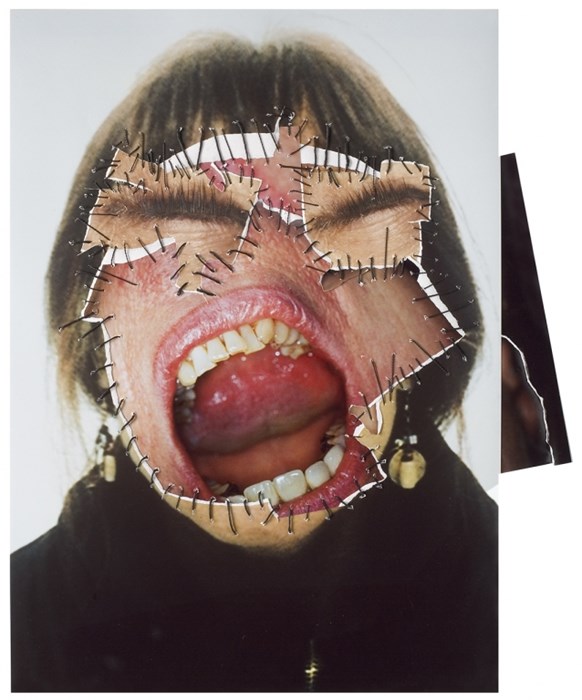Anngeret Soltau – Photomontage |
Annegret Soltau (Born 16 January 1946) is a German visual artist born in Luneburg, Germany. Her work marks a fundamental reference point in the art of the 1970’s and the 1980’s. Photo-montages of her own body and face sewn over or collaged with black thread are the most well known of the artist.
In ‘Selbst’ the artists ties up her face with tight threads of black silk, just like a cocoon, of which she makes a photographic record that is subsequently stitched by following a geometric pattern that resembles a sign. In her Video-Performances and Phototableaus she wanted to make an intimate processes like sexuality, pregnancy, birth, abortion, sickness and violence to become subjects of the arts. From 1977 to 1980 she dealt with her pregnancies of her two children. She asked herself the question: How can I combine creativity and motherhood without losing myself as my own person.
Performance art and photography became a liberation device for Soltau herself as well. After a series of self-portraits that show her in a cocoon made of black thread in various stages of pupation, she made her first sewn photo works in 1975. From that point onwards, her work was influenced by her understanding of human existence as a constant metamorphosis, and the threat to and expansion of the self throughout these changes. She finally became the center of her art: “I am using myself as a model because I can go the farthest with me.”
The tactile drawing with needle and thread, which has been her hallmark ever since, can be found in its probably most aesthetic version in the series of self portraits entitled Verspannungen from the Deutsche Bank Collection . “I liked the simplicity of those photo booth pictures, where you simply sit in the booth. It was important to me that the threads connect the various states like telephone wires.” The threads sewn across the photos follow the outlines of her face like cobwebs. Eyes, nose, and mouth become fixed points in an ornamental work of strapping and sewing that seems like an especially subtle for of self-mutilation. – Article Link

Her imagery, which is both provocative and disturbing, often explores themes related to the self, metamorphosis and the female body. Alongside other artists such as Cindy Sherman and Suzy Lake, Soltau’s work is regarded as a key reference point for feminist art in the 70s and 80s.
In an interview about her work, Soltau says, “Above all I am interested in the image of women. What happens to women these days, how do they present themselves? Which compulsions (and liberties) exist for women today?”
Below is another photo-montage by Annegret Soltau. It is still a self portrait like in the above examples however this was produced a couple of years on and can be seen to have a different style. She has still sewn back into the photograph however this time it is to stitch other pictures onto the original, they have been ripped and placed to create an abstract looking portrait it has a different and almost more powerful effect for her to be stitching the parts together rather than having it seamless by gluing it. It also makes the picture more recognisable to her as it has become one of her signifying techniques.

Other Artist to look at during experimentation:
Jakob Kolding
‘In terms of subject, the work has gone from a relatively specific interest in modernist utopias and suburban space.’
The idea of landscape plays a big part in Berlin-Based Jakob Kolding’s gritty pieces. He likes the fact that every element used references something outside of the work, making for a multilayered and complex experience. He is acutely aware that context always matters and enjoys playing around with this in ‘simple yet meaningful ways’. Collage is always at the heart of his creative process and he admits that ‘even when the work doesn’t look like a collage, that is basically still how I think about it. I like how in the process you can build up your own vocabulary, something very personal by made only out of found images. Nothing comes from nothing.’ – Cuts & Paste (Caroline Roberts and Richard G. Brereton)


